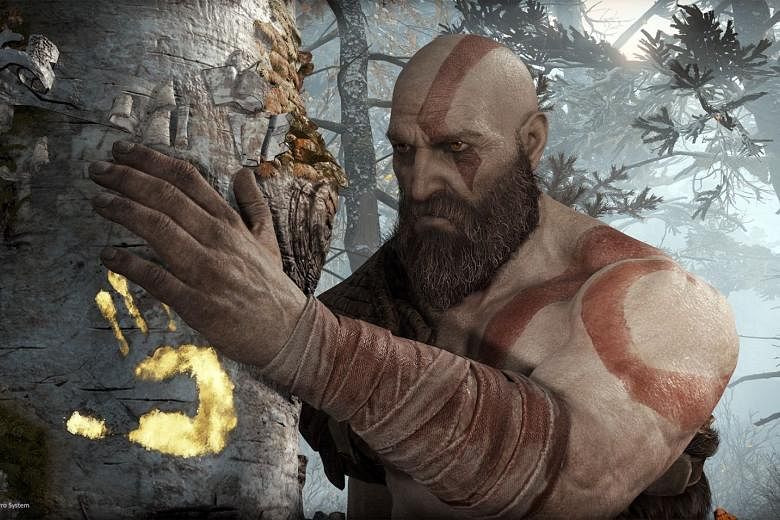Kratos, the titular God of War, is back.
But the angry, vengeance-seeking demigod from previous installments seems to have gone, replaced instead by a weary warrior who looks slightly the worse for wear. He even sports a beard - think Hugh Jackman's Wolverine in the Logan movie - but he remains bald and retains his distinctive red tattoo.
And just like Wolverine in that movie, he now has a young son, Atreus, to nurture and protect.
Of course, I have no idea how the rest of the game will play out, given that I only tried the first two hours of the game in an early preview provided by Sony Interactive Entertainment. But according to developer Santa Monica Studio, Kratos will rediscover his humanity from his relationship with his son, while Atreus will learn how to behave more like a god.
The new game is described as a "reimagining of the series", which explains why it is not God of War IV, even though it comes after the events in God of War III (2010). Kratos is now in the lands of the Norse gods, known as Midgard. It is quite the change in scenery since we last saw him, hurt and dying in a pool of his own blood.
The catalyst for the new storyline is a death. Atreus' mother is dead, wrapped in burial clothing and ready for the pyre. Her wish is to have her ashes scattered from the highest peak of Midgard. So begins the journey for father and son. Hopefully, we'll get the lowdown on what happened before, because I certainly have more questions than answers after my short playthrough.
What was evident in the first two hours is Kratos' tough-love approach to parenting. Acting more like a drill sergeant than a loving dad, the tactiturn Kratos often berates Atreus for not being good enough and offers few answers to his son's many questions. This approach probably makes sense given the dangers faced by them in the wilderness, but Atreus is clearly not an ordinary kid.
In fact, Atreus requires little babysitting by the player, which is a relief. While he is not a playable character, you can order him to shoot arrows to distract the enemy. Thankfully, he (rather the AI powering it) seems quite capable of keeping himself out of trouble.
The combat in the new God of War is a huge departure from previous games. The fixed cinematic camera that lets players see the entire battlefield has been changed to an over-the-shoulder camera that follows Kratos. In other words, he can get blindsided by foes from behind or the sides, though Atreus can shout out warnings and there are different coloured arrow indicators to signal impending threats.
Adding to this feeling of vulnerability is the fact that Kratos seems to have a rather small bar of health, at least in the beginning. I failed a couple of occasions against larger enemies because I could not mow down foes like I could in previous games. I had to play more cautiously, especially when facing multiple enemies.
But I have no doubt that he will get stronger, because the game is now more of a role-playing action game than before. Kratos gains experience points, which can be spent to unlock new skills. Items gathered in the game can also be used to upgrade armour and weapons.
The controls have also been revamped. It should feel familiar to Dark Souls players, as like these games, God of War now uses the right trigger buttons for light and heavy attacks while the left trigger brings up a shield to block attacks.
Kratos has a new Leviathan Axe that replaces his trademark dual blades. The axe can be thrown at distant enemies or objects. Like Thor's Mjolnir hammer, this axe also returns to Kratos upon pressing a button, which seems appropriate given the Norse setting.
The axe is also the key to solving many of the puzzles in the game. Throw it at ropes to cut down objects or to jam up gears to keep doors or bridges open. Or use it to smash chests and barrels for a chance at getting some loot.
Other changes that I like: there is not a single platform-jumping puzzle to be found, and there are no quick-time events that rely on players mashing the correct button at the right moment. Kratos still has a finishing move that will instantly kill an opponent, but only when the enemy is stunned after being hit repeatedly by him. He also retains his Spartan Rage ability that turns him near-invincible for a short while.
Overall, God of War feels polished, with the high production values that you'd expect of a big-budget game. But there was no epic, jawdropping moment in my playthrough. Perhaps it was because the game was easing me into the new mechanics and gameplay at the start -the trailers certainly hint at more interesting encounters than the ones I had so far.
Visually however, the game looks stunning. Kratos' beard is rendered in great detail and you can see the small puffs of breath (due to the cold) from his mouth. It also runs fluidly on the PlayStation 4 Pro without any lag, though it does not run natively at 4K resolution. Instead, the resolution is upscaled via checkerboard rendering, a common graphical technique used by other console titles. There is also support for high dynamic range (HDR), so those using a newer HDR-compatible TV set will be able to enjoy richer, more realistic-looking visuals.
God of War will be released on April 20 exclusively for the Sony PlayStation 4. The digital version is priced at $64.90 while a physical copy costs $72.90. Sony also sells a limited edition God of War PS4 Pro bundled with the game at $669.






